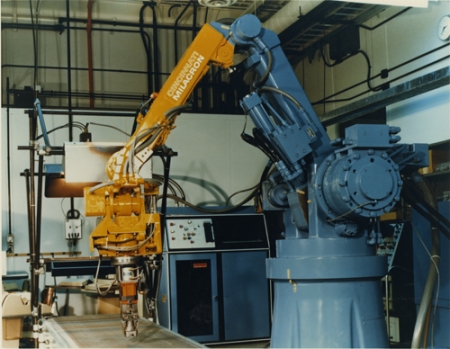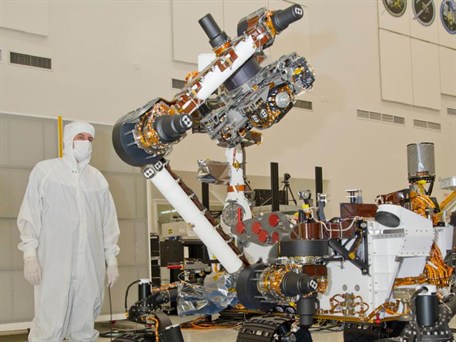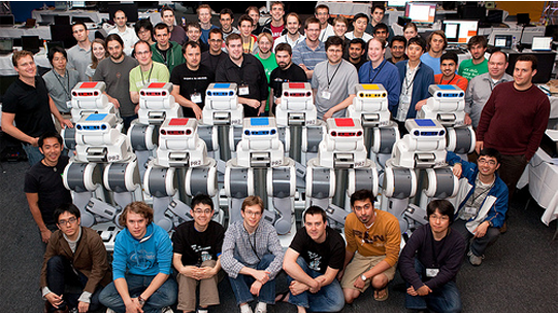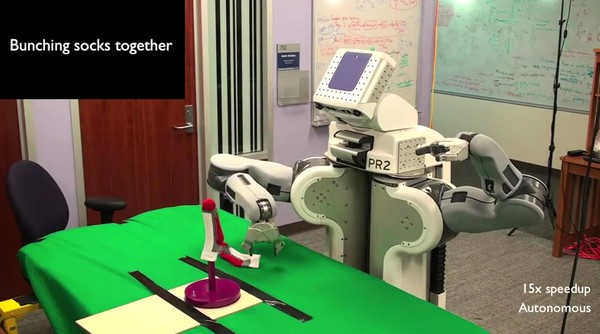When I started studying robotics what was out there included industrial behemoths from companies like Cincinnati-Milacron. These were evolved numerical control devices, successors to tool and die equipment and paper tape controllers, used for manufacturing everything from screws to automobiles. The year was 1973. The first robot I ever saw was the T3 (see picture below). It was partnered with workers on an assembly line and was doing precision spot welding. The T3 was a monster in size and weighed several tons. A minicomputer was need to program it.
In 1976 NASA and the Jet Propulsion Laboratory created and launched the two Viking Martian landers. On board were two robotic arms controlled by a microcomputer. These were the arms that dug the first soil samples from the Martian surface hatching the controversy about whether Mars harbored life or not, a question that remains unanswered to this day.
Today most robots can be found in manufacturing or the military. A few are finding their way into domestic use such as the iRobot line of Roomba vacuum cleaners. Robots are continuing to change, becoming faster, more nimble, capable of specializing in a single task or being used for multiple tasks.

Compare the T3 seen above with the articulated robotic arm on Curiosity, the Mars Science Laboratory (seen below). You can see that in a matter of less than 40 years robotic arms have dramatically improved. Curiosity’s arm is 2.1 meters (7 feet) in length and unlike the T3 which served a single purpose, this arm includes a set of tools with wide ranging application. The arm has an on board colour camera that features a high resolution zoom lens. In addition the arm has a drill, alpha particle x-ray spectrometer, a CheMin mineral and chemical analyzer, SAM, an atmospheric gas analyzer, RAD, a radiation detector, DAN, a hydrogen, ice and water detector, and a scoop for recovering and testing surface and sub-surface soil samples. The arm is dexterous and capable of turning almost an entire full circle.

Where Robots are Going From Here
The next evolution of robots is taking us well beyond specialty robots and into the realm of more generalized usage. This comes courtesy of a number of organizations including one that recently made the news, Rethink Robotics, an offshoot of the robotics program at Massachusetts Institute of Technology. The company’s founder is Rodney Brooks, a co-founder of iRobot. At Rethink the mission is to make robots fit places where automation has never been practiced, in particular, small and mid-size businesses. Rethink robots will be designed to learn and become productive a few hours after coming out of the box. Each will be capable of working collaboratively with nearby humans. Each will have fine motor control, machine vision, tactile touch sensors, and multiple arms. And each will be easily reconfigurable for new work assignments.
Rethink is joined by other companies in a race to produce new robotic capability that will broaden the technology’s usage in business and in our personal lives. Among these are:
- Kuka Roboter GmbH, the number one PC-based controller robot manufacturer in the world
- Motoman Robotics, a wholly-owned subsidiary of Yaskawa Electric Corporation of Japan with 230,000 industrial robots installed worldwide
- Redwood Robotics,a joint venture of Meka Robotics, Willow Garage (see below) and SRI International
- FANUC Robotics, one of the pioneers, a Japanese company with over 250,000 robots installed worldwide in industries including aerospace, automotive, energy, consumer goods, food, machine tool, and bio-pharmaceuticals.
- Staubli, a Swiss company that dates back to 1892, originally focused on textile machinery and now a manufacture and supplier of a wide range of robotic arms, controllers, and software for many industrial applications
Open Source Comes to Robotics
Willow Garage is a company founded by Scott Hassan in 2006 to develop robots for non military applications using open source software to encourage independent third parties to develop the technology further. Willow Garage has developed the Robot Operating System or ROS, a library of tools for developers to create robot applications. Through its online Internet forum the software is offered freely to anyone to use, enhance or to build commercial products.
Willow Garage has created the PR2, a robot development platform for testing new robot applications and technologies. PR2 comes with a robotic arm that features a flexible wrist joint and gripper capable of holding everything from towels to brooms. The PR2 has spawned an active research community that includes universities from around the world.











Soon Home robots like maid in Jetsons TV show.
Lost in Space TV show Robot.
I Robot via DARPA project.
& for wide apps:
Security
Mining
drilling
Rescue
salvage
firefighting
games.